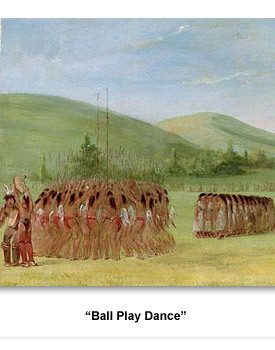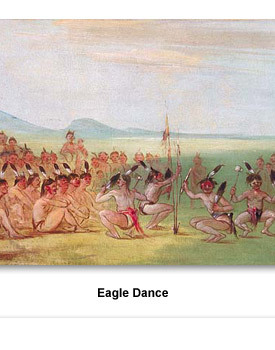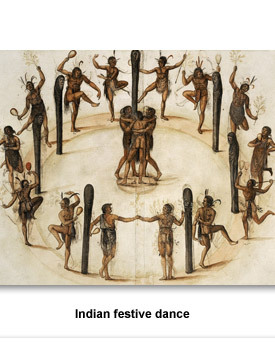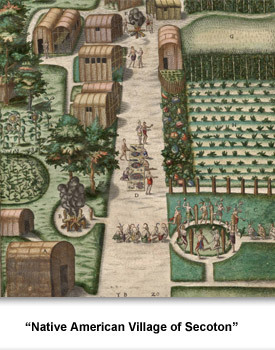Indians & Cultural Encounters
Arts
Music, stories, and dance were an important part of Indian ceremonial and religious life. Only a few types of instruments have been described or re-cover-ed, so much of the music may have been vocal.
The most important instrument was the drum. Indians made drums by stretching skins over a hollow container. Tennessee Indians also used rattles made from gourds or turtle shells with beans, grains of corn, or pebbles inside. Women often wore turtle shell rattles around their lower legs in dances.
Another instrument was the flageolet. It was similar to a flute. Indians did not use it just to accompany songs or dances. They also used it during important social or political occasions, such as welcoming important visitors.
Most songs were short. They lasted from a few seconds to a few minutes. Singers and musicians often repeated phrases during a song. The number of repetitions often represented sacred numbers in a tribe’s religion.
Many songs known today have long histories. They may or may not be the same as they originally were. Indian music may have changed over time as Indians had more and more contact with European and African culture .
Listen to a traditional Cherokee song, Stomp Dance.
http://tn4me.org/audio/Cherokee_Stomp_Dance.mp3
Dances contained many spiritual symbols. Dancers usually moved slowly and gracefully in circular patterns around a fire. Male dancers moved around the fire in a counter-clockwise direction. Female dancers moved inside the men’s circle, closer to the fire and in the opposite direction.
Stories were an important way of passing knowledge from one generation to the next. It was also a method of explaining their world. Many stories also had a moral to them—a lesson for the listeners to learn. Read a traditional Cherokee story about the possum’s tail.
Picture Credits:
- A drawing of the “Native American Village of Secoton.” Several buildings are pictured as well as crop fields, and a vegetable garden. A dance ceremony is visible at the bottom of the image, while other villagers eat, talk, tend fires, and hunt. Originally drawn by John Whyte this picture was included in the book A Briefe and True Report of the New Found Land of Virginia by Thomas Hariot. Later the image was engraved by Theodor de Bry and reprinted in 1590. De Bry wanted to make Native Americans look more like Europeans, so he drew them with blonde hair and white skin. Although the drawing is not entirely accurate, it demonstrates how some Europeans did not understand or appreciate the ways in which Native Americans were different from them. The Indians pictured belong to the Southern Algonquian group of Indians and are related to the Shawnee. North Carolina Collection, University of North Carolina.
- A painting of the Choctaw “Ball Play Dance.” This painting was created by George Catlin in 1834. The Ball Play dance was performed before a Ball game. The Choctaw Indians traditionally resided in central Mississippi and are related to the Chickasaw Indians. Smithsonian Art Museum.
- A painting of the Choctaw “Eagle Dance.” This painting was created by George Catlin around 1835. The Choctaw Indians traditionally resided in central Mississippi and are related to the Chickasaw Indians. Smithsonian Art Museum.
- A drawing of an Indian festive dance. The picture shows Indians dancing around wooden posts arranged in a circle, while three people stand together in the center. Several people are also shown wearing head dresses and waving plants and rattles made out of gourds. Originally drawn by John Whyte this picture was included in the book A Briefe and True Report of the New Found Land of Virginia by Thomas Hariot. Later the image was engraved by Theodor de Bry and reprinted in 1590. The Indians pictured belong to the Southern Algonquian group of Indians and are related to the Shawnee. Trustees of the British Museum.
Acknowledgments:
"Stomp Dance, Cherokee." Performed by Luman Wildcat, Leona Wildcat, and Eli Sam. Songs of Earth, Water, Fire, and Sky: Music of the American Indian. New World Records, 1976.
Indians & Cultural Encounters >> Indian Life >> How They Lived >> Arts




 Sponsored by: National Endowment for the Humanities
Sponsored by: National Endowment for the Humanities